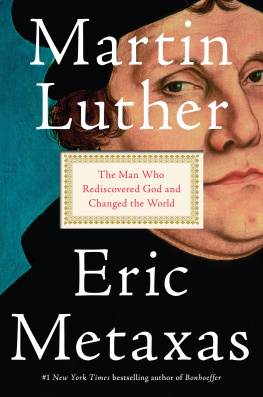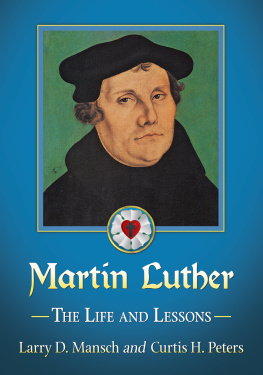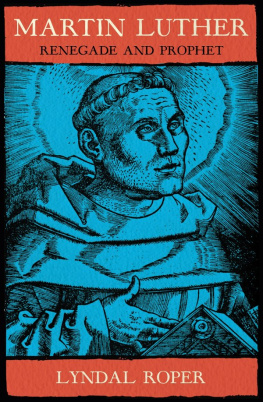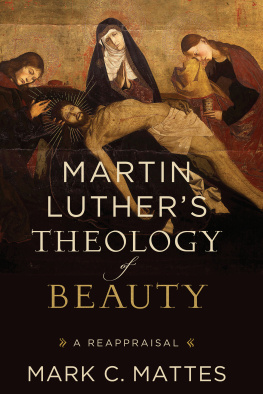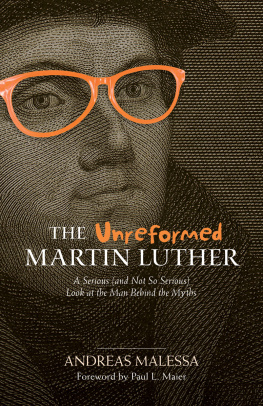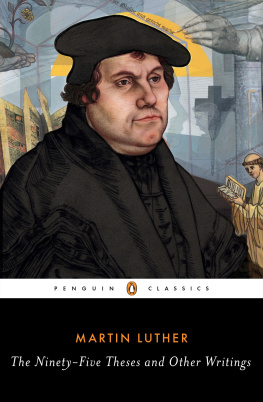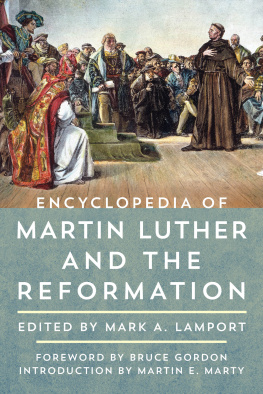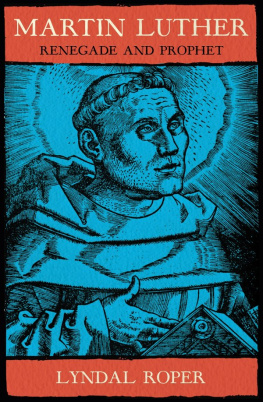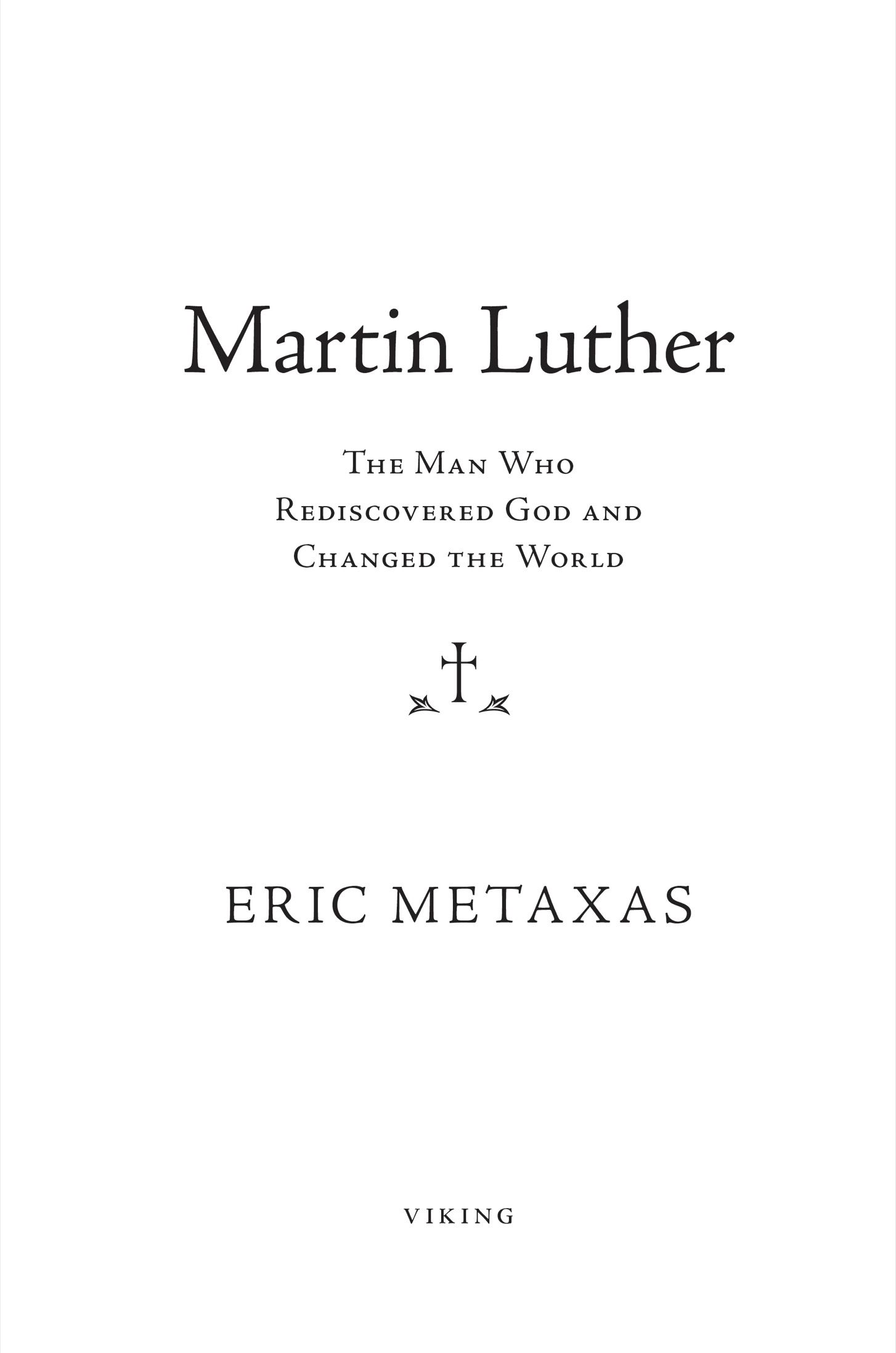Penguin supports copyright. Copyright fuels creativity, encourages diverse voices, promotes free speech, and creates a vibrant culture. Thank you for buying an authorized edition of this book and for complying with copyright laws by not reproducing, scanning, or distributing any part of it in any form without permission. You are supporting writers and allowing Penguin to continue to publish books for every reader.
Map by Jeffrey L. Ward
Photograph and illustration credits appear .
This book is dedicated to my friends Markus Spieker and Dr. Gregory Alan Thornbury
CHRONOLOGY
1483 Luther is born in Eisleben on November 10 and baptized the following day. He is the eldest of what history believes to be eight children born to his parents, Johannes Hans Ludher and Margarethe Ludher ne Lindemann.
1484 Luthers parents move to Mansfeld when he is around six months old. This is where they will raise all of their children and remain for the rest of their lives.
1490 Martin is sent to school in Eisenach.
149697 Martin attends school in Magdeburg for one year.
1501 Martin goes to the University at Erfurt.
1505 Martin begins his law studies at Erfurt.
1505 Martin vows to become a monk on July 2 while traveling through the village of Stotternheim. He enters the Augustinian monastery in Erfurt and takes holy orders.
1506 Martin meets Johannes von Staupitz.
1507 Martin is ordained and performs his first Mass with his parents and others in attendance.
1508 In the fall, Staupitz sends Luther to Wittenberg for a year.
1509 While at Wittenberg, Martin receives his bachelors degree in the Bible.
151011 Martin makes walking pilgrimage to Rome.
1511 Staupitz transfers him to Wittenberg monastery, where he will remain throughout his life.
1512 Under a pear tree, Staupitz persuades Luther to study for his doctorate. Luther earns his doctorate.
151317 Luther lectures on Psalms, Romans, Galatians, and Hebrews, laying the exegetical foundation for all that lies ahead.
1517 Luther posts his Ninety-five Theses (traditionally on October 31) and mails a letter and the theses to Archbishop Albrecht at Magdeburg.
1518 Luther speaks at the Heidelberg disputation in April. Melanchthon arrives in Wittenberg.
1518 Luther travels to the diet at Augsburg in October and appears before the papal legate Cardinal Cajetan.
1519 Leipzig debate with Johannes Eck in July.
1520 Luther writes his three powerful works: To the Christian Nobility of the German Nation; The Babylonian Captivity of the Church; and The Freedom of a Christian.
1520 Leo X writes the papal bull Exsurge Domine, giving Luther sixty days to appear in Rome to answer the accusations of heresy.
1521 The sixty days expire, and Leo X officially excommunicates Luther. Luther burns the bull and other writings in Wittenberg.
1521 Luther appears at the Diet of Worms in April.
1521 In May, following Luthers imperial condemnation as a heretic and outlaw, Frederick arranges for him to be kidnapped and taken to his exile at the Wartburg Castle, where he remains incognito for ten months.
1521 In December, Luther travels incognito to Wittenberg for a short visit. Cranach paints a portrait of him as Junker George.
1522 Luther translates the New Testament into German in eleven weeks at the Wartburg. In March, he returns to Wittenberg and preaches his eight Invocavit Sermons, reversing the excesses that Karlstadt and Zwilling began in his absence, and resumes leadership of the Reformation at Wittenberg.
1523 In February, Luthers German translation of the New Testament is published.
1525 German Peasants War. Mntzer is killed.
1525 In June, Luther marries Katharine von Bora. Karlstadts family arrives in Wittenberg; Luther writes On the Bondage of the Will.
1526 Johannes Hans Luther is born.
1527 In December, a daughter, Elisabeth, is born.
1528 In August, Elisabeth dies, aged seven months.
1529 In May, a second daughter is born, named Magdalena (Lenchen); Marburg Colloquy in October.
1530 The Diet of Augsburg. Luther remains at the Coburg Castle during this time.
1531 In November, a son, Martin junior, is born.
1533 In January, a son, Paul, is born.
1542 Luthers thirteen-year-old daughter, Lenchen, falls ill. She dies in her fathers arms on September 20.
1546 Luther travels to Eisleben with his three sons. Preaches his last sermon on February 14 or 15. Dies there on February 18. Buried at Wittenberg.
INTRODUCTION
Pastor, Rebel, Prophet, Monk
I N 1934 , AN African American pastor from Georgia made the trip of a lifetime, sailing across the Atlantic Ocean, through the gates of Gibraltar, and across the Mediterranean Sea to the Holy Land. After this pilgrimage, he traveled to Berlin, attending an international conference of Baptist pastors. While in Germany, this manwho was named Michael Kingbecame so impressed with what he learned about the reformer Martin Luther that he decided to do something dramatic. He offered the ultimate tribute to the mans memory by changing his own name to Martin Luther King. His five-year-old son was also named Michaeland to the sons dying day his closest relatives would still call him Mikebut not long after the boys father changed his own name, he decided to change his sons name too, and Michael King Jr. became known to the world as Martin Luther King Jr.
This father-and-son name change is just one dramatic measure of the influence of Martin Luther. Luthers writings and actions so altered the landscape of the modern world that much of what we now take for granted may be traced directly to him, the quirky genius of Wittenberg.
For example, the quintessentially modern idea of the individualand of ones personal responsibility before ones self and God rather than before any institution, whether church or statewas as unthinkable before Luther as is color in a world of black and white; and the similarly modern idea of the people, along with the democratic impulse that proceeds from it, was createdor at least given a voiceby Luther too. And the more recent ideas of pluralism, religious liberty, and self-government all entered history through the door that Luther opened to the future in which we now live.

